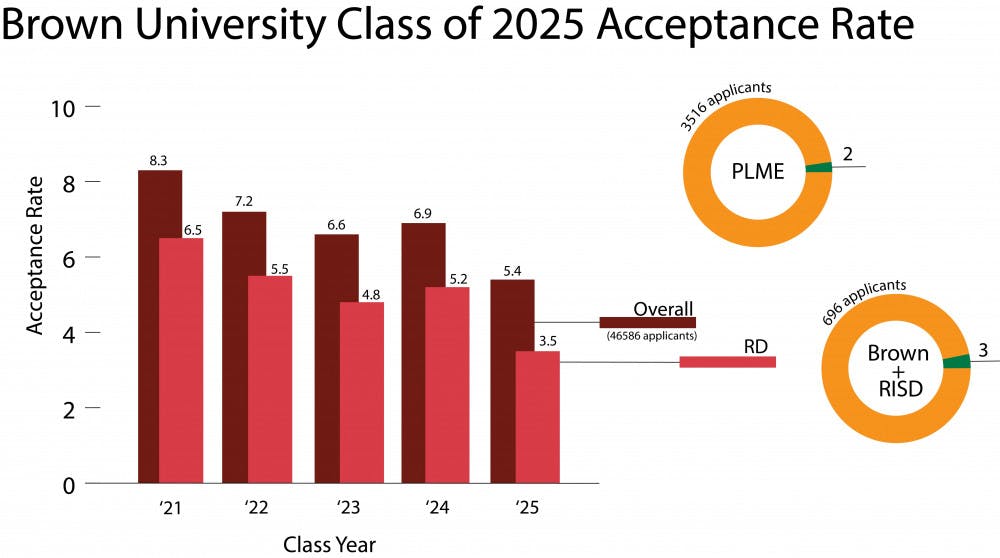The University extended offers of admission to 1,652 students tonight, bringing this year’s overall acceptance rate to a record-low of 5.4 percent, according to Dean of Admissions Logan Powell.
The acceptance rate for the class of 2025 marks the first time the University has admitted fewer than six percent of applicants. Last year, the University accepted 6.9 percent of applicants to the class of 2024; the previous record low came the year before, when only 6.6 percent of applicants were admitted to the class of 2023.
Regular decision applicants were admitted at a rate of 3.5 percent, breaking the previous record low of 4.8 percent, also set by the class of 2023. Last December, the University admitted 885 students who applied during the early decision round, for an acceptance rate of 15.9 percent.
“We feel a great sense of joy for the students who are invited to join the Brown community,” Powell said. “Their academic credentials are superlative. What they shared with us on a personal level was insightful and powerful.”
Equally impressive, he said, was the “strength and resilience” they showed in the face of a high school senior year impacted by COVID-19. Many admitted students engaged in the “fight for racial justice” as well as advocating for “real solutions for climate change,” Powell added.
Still, Powell added, the process of paring down a record-large applicant pool was a challenge — and uncertainty still looms over parts of the process.
46,568 students applied to the class of 2025 during both regular and early decision combined, a 27 percent increase over last year’s pool and a jump of nearly 8,000 from the previous record held by the class of 2023 at 38,674 applicants — making for decisions that proved “agonizing” at times.
“You wish you could communicate to all of the other applicants to tell them how amazing they are as well,” he noted. “You’re forced, with the constraint of a relatively small student body, to select from a truly dazzling array of diversity and perspective.”
Powell added that the University likely could have admitted “two or three” classes with nearly “indistinguishable” academic credentials to those of the admitted students.
Two percent of applicants to the Program in Liberal Medical Education were admitted, among a pool of 3,516 students. The University also admitted three percent of 696 students who applied to the Brown-RISD dual degree program.
Across all admitted students — 2,537 including both regular and early decision — 55 percent self-identified as students of color, and 17 percent would be the first members of their families to attend college. Sixty-nine percent of students admitted regular decision applied for financial aid, adding to the 59 percent of students who were admitted in the early decision pool.
Admitted students, Powell said, come from all 50 states as well as Washington, D.C. and Puerto Rico; international students represent 72 countries as a whole, with China, India, the United Kingdom, Canada, Turkey and South Korea sending the most students from abroad.
But constructing the class does not end with admission decisions, Powell explained.
In a normal year, the University welcomes 1,665 first-year students — though that number could climb up to as many as 1,700 students to accommodate the roughly 80 students admitted last spring who took gap years and will matriculate this fall.
The University expanded the size of class of 2025, Powell said, in an effort to keep the playing field as level as possible for students applying this year, instead of “artificially disadvantaging” new first-year applicants by eliminating 80 possible spots.
Accepted students are required to inform the University if they’ll matriculate in the fall on May 3 — a date shared by every other Ivy League school. If the University comes in under its targeted yield due to students accepting admission offers elsewhere, as is a regular occurrence at most colleges, it will pull students off the waitlist until the class is complete. This year, that process is harder to predict, Powell said.
“Large majorities of applicants, not just to Brown, but to other colleges and universities, never got to see the colleges and universities to which they were applying,” he said.
“There is no historical comparison for this in the modern era, where you have an entire class of graduating seniors who by and large were not able to visit college campuses, didn’t sit in on classes, weren’t able to go to the dining hall — their decision-making in the absence of the real, tangible college visit could shift a bit,” Powell said.
Every “Ivy Plus” institution has committed to offering virtual admitted student programs, Powell added.
Powell further speculated that around the country, students who are deciding between highly selective institutions might defer to “known quantities,” such as preferring campuses closer to home rather than schools that feel like more of an “unknown.”
In a normal year, between 900 and 1,000 students accept the University’s offer to be placed on its waitlist, Powell said. This year, the University made slightly more waitlist offers than usual, with the expectation that roughly 1,000 to 1,250 students will likely choose to remain on the list. “The hope is (to notify waitlisted students) by the end of June,” he noted, adding that the University complies with relatively recent changes to deadline policy from the National Association for College Admission Counseling. “We want students to have certainty as early as they can. We don’t want students waiting into the end of August while they’re packing to go to another school.”

Will Kubzansky was the 133rd editor-in-chief and president of the Brown Daily Herald. Previously, he served as a University News editor overseeing the admission & financial aid and staff & student labor beats. In his free time, he plays the guitar and soccer — both poorly.





